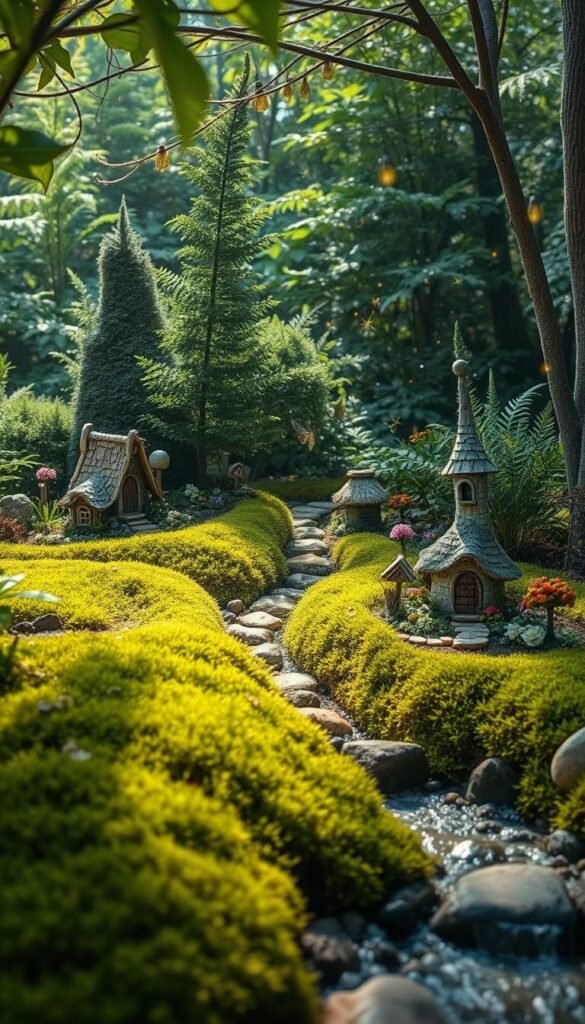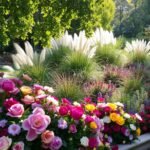What begins as a simple pile of twigs and pebbles can transform into a world of wonder. Leslie Alvis, an Ohio mom, learned this when her toddler sparked a family tradition during a vacation. “We gathered moss and stones under an old oak tree,” she recalls. That spontaneous project became a gateway to endless creativity, now enjoyed by all four of her children.
These miniature landscapes do more than entertain. They blend outdoor exploration with storytelling, letting kids shape tiny worlds using leaves, pinecones, and imagination. Best of all? No fancy supplies are needed—just curiosity and nature’s free treasures.
Families across the U.S. are discovering how these whimsical setups encourage observation skills and artistic expression. Toddlers marvel at textured bark, while older kids engineer elaborate villages. As DIY fairy garden projects show, even basic materials like clay or lavender stems spark adventures.
Ready to craft your own corner of magic? This guide reveals how ordinary backyards become stages for extraordinary tales. You’ll learn to design flexible spaces that evolve with your child’s ideas—turning rainy afternoons into quests and garden nooks into realms ruled by tiny guardians.
Discovering the Magic of Fairy Gardens

Tiny acorn caps become soup bowls. Fallen branches transform into bridges. This is the secret language of miniature gardens, where ordinary backyard finds spark extraordinary adventures. Long before these whimsical spaces went viral, families like Leslie Alvis’ were crafting tiny realms from pinecones and moss. “We’d spend hours arranging pebble pathways,” she shares, recalling how her kids imagined fairy feasts under mushroom caps.
Understanding the Concept and History
These enchanted spaces trace their roots to ancient folklore about woodland spirits. Today’s versions blend gardening with creative play—think terrariums meets dollhouse design. Ed Cooper, who leads workshops in Maryland, notes:
“Grandparents now bond with grandkids over fairy house construction. It’s nature’s LEGO set.”
Liza Gardner Walsh’s research reveals surprising twists. Kids often invent unexpected features like recycling centers for fairies or leaf hammocks. This evolution from simple rock piles to complex villages shows how imagination grows with the garden.
Why Fairy Gardens Spark Imagination
The magic lies in scale. Miniature landscapes let children rule kingdoms smaller than their palms. A cracked flowerpot becomes a castle ruin. Twigs form ladders to cloudberries. “They’re not just decorating—they’re world-building,” explains Walsh.
These living dioramas teach storytelling through seasons. Spring’s blooming flowers might signal a fairy wedding. Autumn acorns could stock a tiny pantry. As families collaborate, nature connection grows alongside creativity—one pebble bridge at a time.
Your Guide: How to Build a Fairy Garden: Imaginative Play in the Backyard

The hunt for natural treasures begins right outside your door. Leslie Alvis, who’s created dozens of these spaces, advises: “Start with what’s already there—twigs become fences, pebbles turn into stepping stones.” This approach turns ordinary bits of nature into extraordinary storytelling tools while teaching kids to see their surroundings with fresh eyes.
Gathering Materials from Nature
Your backyard holds everything needed to make fairy garden wonders. Fallen leaves craft tiny blankets. Pinecones transform into rustic chairs. Nature’s free supplies offer endless possibilities—no store trips required. Foraging doubles as a gardening activity that builds fine motor, letting little hands practice sorting acorns or arranging moss carpets.
Choosing the Ideal Location in Your Yard
Seek out natural stages where magic happens effortlessly. Tree roots create instant caves, while flower beds frame vibrant landscapes. Ed Cooper’s team chose a magnolia tree surrounded by blossoms, proving even small yards have perfect spots. Always check for safety—avoid plants like oleander that could harm curious explorers.
Shaded areas protect delicate moss gardens, while sunny patches let miniature flowers thrive. Involve kids in testing locations: “Does this place feel enchanted?” Their answers might surprise you—a forgotten corner often holds the most potential.
Creative Design: Selecting Materials and Plants
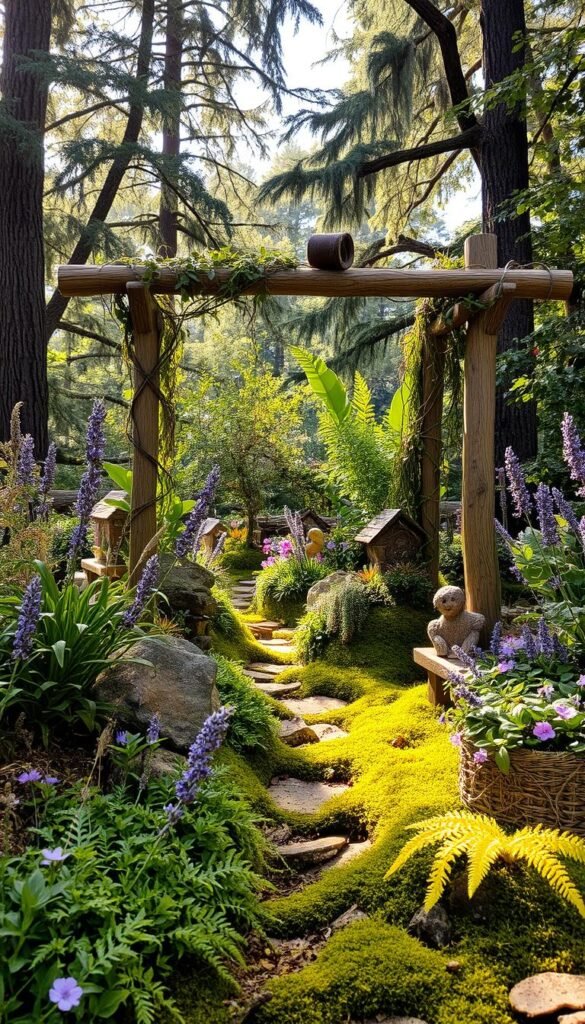
The secret to a thriving miniature wonderland lies in pairing resilient plants with whimsical accents. Whether crafting a sunlit meadow or shaded grove, your choices determine whether magic wilts or flourishes.
Finding Natural Elements and Unique Details
Nature offers readymade decorations that spark stories. Bark becomes weathered walls, while smooth stones form seating areas. Seed pods double as fairy bathtubs, and curled leaves make perfect hammocks. For lasting ornaments, Mark Miller suggests:
“Pet stores often sell miniature bridges and caves for fish tanks—they withstand weather better than most craft-store finds.”
| Plant Type | Water Needs | Sunlight | Best For |
|---|---|---|---|
| Succulents | Low | Full sun | Dry landscapes |
| Moss | High | Shade | Forest scenes |
| Pansies | Moderate | Partial sun | Color accents |
Tips for Picking Kid-Friendly Plants and Ornaments
Choose plants with similar care needs to simplify maintenance. Group drought-tolerant succulents together, or create a moisture-loving zone with moss and pratia. Avoid toxic varieties like lily-of-the-valley if young helpers participate.
Involve children in selecting smooth rocks and lightweight pinecones. These bits become movable props for evolving stories. For indoor projects, layer pebbles and activated charcoal beneath soil to keep roots healthy—a trick that makes terrariums thrive for months.
Step-by-Step Planning and Building Process
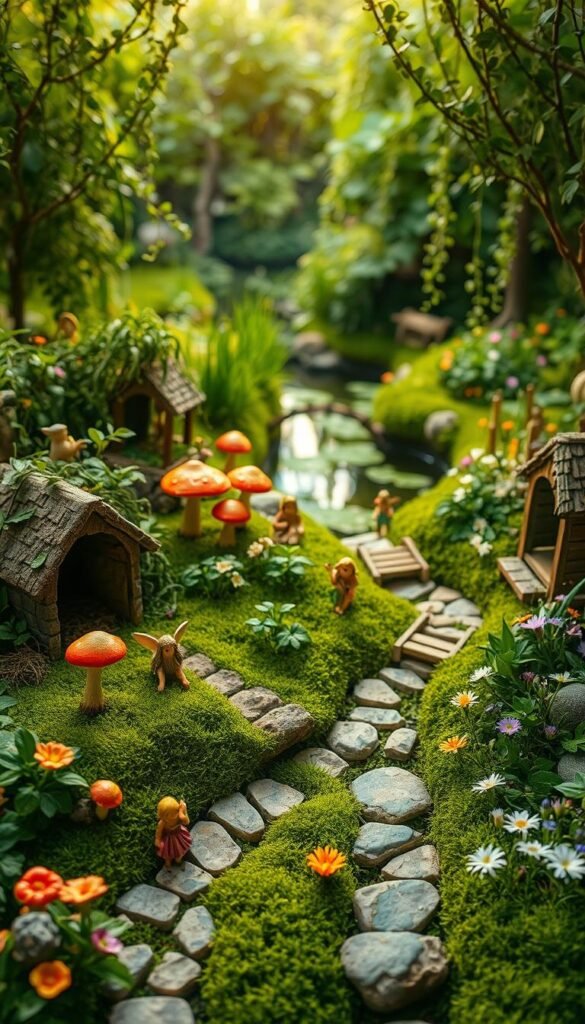
Every enchanted realm begins with a vision. Start by sketching rough ideas on paper or arranging materials directly in your space. Kristin Strandlund, a Minneapolis preschool director, suggests: “Let kids place plants on the soil surface first—it’s like a dress rehearsal for magic.” This hands-on planning helps spot opportunities, like turning tree roots into secret tunnels.
Mapping Out Your Fairy Garden Layout
Containers need smart foundations. Mark Miller’s method works wonders: layer pebbles for drainage, activated charcoal to keep soil fresh, then potting mix. For yard setups, identify natural fairy house locations—a mossy stump or flowerbed edge. One family created stone shelves using bark and grass nests, proving creativity thrives within simple frameworks.
Constructing the Fairy House and Paths
Build your tiny dwelling with weather-resistant materials. Bark walls and pinecone roofs withstand rain, while acorn caps make charming windows. Twig benches tied with twine add character, and seashell ponds create gathering spots. Connect everything with pebble trails pressed into soil—they guide both fairies and young explorers.
Struggling with stubborn pieces? Let kids problem-solve. A crooked stick might become a bridge, while cracked pots transform into climbing walls. As you work, discuss how this gardening activity builds curiosity through trial and error. Remember: the best gardens evolve as imaginations grow.
Nurturing Your Miniature Garden and Encouraging Play
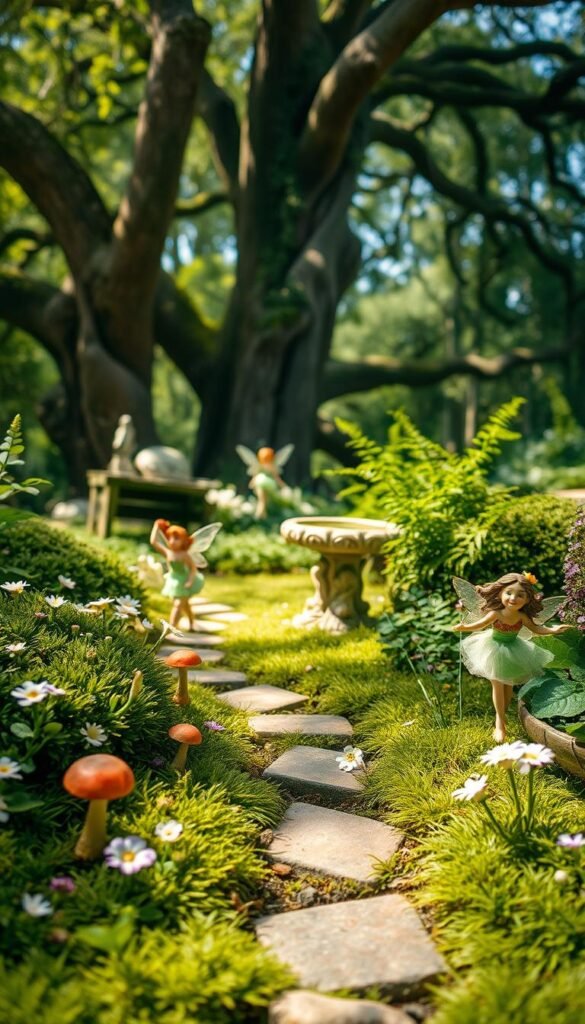
A thriving fairy garden becomes a living storybook where care and creativity intertwine. Leslie Alvis shares how her kids transformed ordinary yard debris into daily adventures: “They’d check their tiny realm every morning, adjusting stones to make better fairy beds.” This blend of stewardship and fantasy keeps the magic alive through seasons.
Long-Term Care Tips for Your Fairy Garden
Keep your miniature world lush with simple routines. Water succulents sparingly but mist moss daily. Rotate plants every few months—swap pansies for snowdrops when temperatures drop. Weatherproof decorations by sealing wooden pieces with beeswax, ensuring tiny benches survive rain showers.
Involve young helpers by assigning age-appropriate tasks. Preschoolers can polish pebble paths, while older kids track plant growth in journals. “My daughter waters her clump of grass daily,” Alvis notes. Responsibility blooms when tending feels like nurturing fairy friends.
Engaging Your Children in Imaginative Outdoor Play
Spark endless stories with open-ended prompts. Ask: “What secret message might the fairies leave under this mushroom?” Add seasonal props—acorn harvests in fall, flower crowns in spring. These tweaks refresh the space without overhauling it.
Watch as kids invent elaborate scenarios. One might build a leaf hospital for injured bugs, while another stages pinecone parades. Alvis laughs: “My son once spent two days constructing a bark library—complete with bookworm residents.” Step back often, letting their ideas shape this ever-changing world.
Final Flourishes: Celebrating Your Enchanted Outdoor Space
Your backyard’s newest attraction isn’t just a garden—it’s a launchpad for wonder. Leslie Alvis smiles as she watches her children revisit their creation daily: “They’ll rearrange pebbles for fairy picnics or add flower petals as welcome mats.” These spaces become living storybooks where dirt-stained hands write tales only limited by the sky.
Parents report magical transformations. One notes their child now races outside each morning to check for fairy messages. Such enthusiasm shows why these miniature gardens outlast fleeting toys. They grow with kids—toddlers stack stones while preteens craft intricate bark villages.
Celebrate your enchanted space by adding seasonal touches. Swap daisies for autumn leaves, or create snowy scenes with cotton-ball clouds. For crafty accents, explore personalized garden art that complements your tiny realm. Remember: perfection isn’t the goal. A crooked twig bridge or lopsided mushroom only adds character.
As years pass, your family’s shared memories will root deeper than any plant. What begins as a weekend project becomes a timeless retreat—a place where imagination blooms wilder than the flowers.
